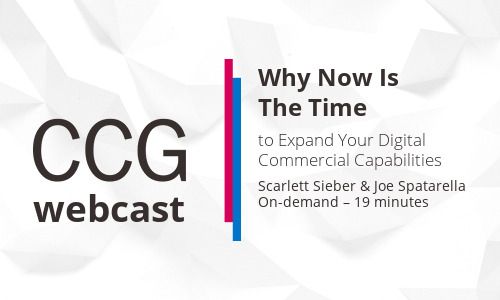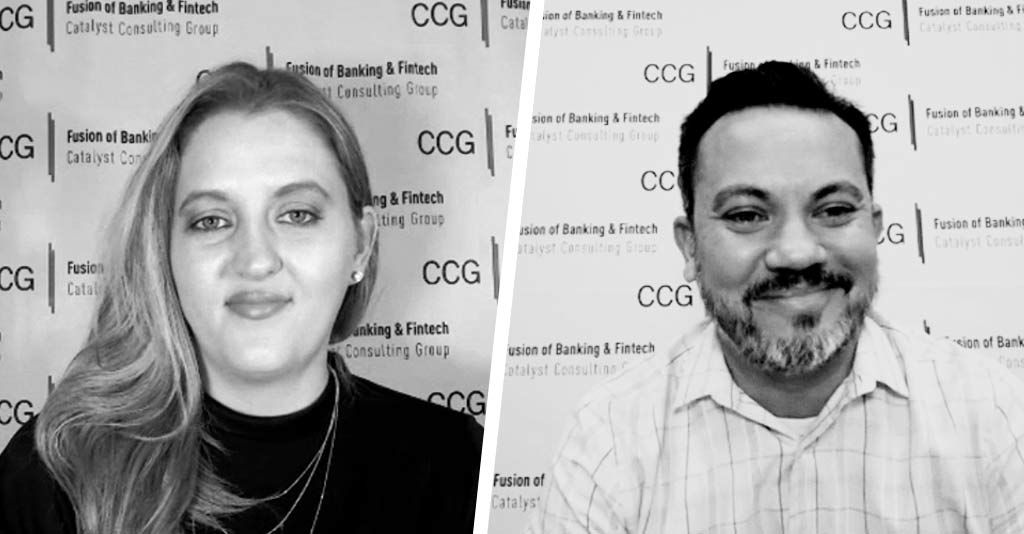Available On Demand – 18 minutes
Join the CCG team for a fireside chat with Scarlett Sieber and industry veteran Joe Spatarella discussing why now is the time to expand your digital commercial capabilities. The commercial side of digital is far behind that of the consumer, now more than ever, you don’t want to be playing defense and the last to the show. Listen in as Joe walks through practical steps on how to build out your digital commercial capabilities while continuing to do business with a focus on achieving customer and revenue growth. This chat is not to be missed!
[restrict]
Scarlett Sieber: Hello. Welcome back, everyone. We are here with CCG’s webinar focused on everything that you care about related to banking. This specific series is focused on commercial digital banking. I am your host, Scarlett Sieber, Managing Director, Chief Strategy and Innovation Officer here at CCG. And again, for this commercial banking series, I’m joined by my new and incredible colleague, industry veteran Joe Spatarella, who is Principal here at CCG Catalyst. Joe, thanks so much for being here.
Joe Spatarella: Thank you and I appreciate being here Scarlett.
Scarlett Sieber: Absolutely. And before we get started, if you did not join us for Episode 1 of this series, which was really about unlocking your existing capabilities, this Episode 2 is really going to be focused on why now is the time to expand your digital commercial capabilities. So what’s most important is we really need to look at a few things. If you look at the bottom of your screen, you’ll see a few different buttons. The first is our bios. You’ll see a nice little picture of Joe and I together. Go ahead and click on that. You will be able to access us directly on our email, find us on LinkedIn and see more of our background. We also have a resource where you see that CCG logo at the bottom of your screen. You’ll be able to click on a link about who CCG is, our background as a whole, as well as an article that Joe just wrote on the topic of digital banking and now is the time, the catalyst for change. Any other questions you can ask down in the Q&A, we will be reaching out to you throughout that process. OK. So without further ado, let’s get started. So we are now migrating over from unlocking your current capabilities to really why you have to think about expanding your existing capabilities on the commercial side. So let me ask a somewhat naive question to you to get us started. Don’t most banks already offer online banking services and really why now? What are the benefits of expanding your digital commercial capabilities?
Joe Spatarella: That’s a great question, Scarlett. The fact is, that a lot of banks and some credit unions do offer online banking services for commercial clients, but they’re doing it rather defensively. It’s sort of a good enough strategy, a defensive approach to the market. We were quickly moving from these digital online banking services on the commercial side from being nice to have more convenience to a have to have. And really, what I think what we in the industry calling a digital first strategy. So, it’s important that these institutions reconsider their positioning and look at how to better enable their digital commercial services.
Scarlett Sieber: That makes sense, and so when we think a little bit more specifically, what is the relationship between Treasury management and digital commercial banking services and how dependent is Treasury on these digital services?
Joe Spatarella: Sure. So, I think the first thing I should add is that the benefits overall are really generating fee-based revenue. And I think in an era where credit is going to be pretty tight, in terms of balancing out bank revenues is key from my C-suite perspective. It also provides the ability to better service commercial customers, have customer retention and be able to grow the client base. So treasury management and cash management are really focused on maximizing cash flow cash, cash reserves, cash pool. So essentially whether it’s receivables, payables, borrowing or investment, it’s all very dependent on really two things. One is information right up to the minute, real time information about what is the cash position. And then the ability to move money, whether it’s borrowing to fund the deficit in that cash pool or investing those funds or leveraging those funds for commerce. So all of that is key not just in domestic cash management, international treasury management as well where we’re dealing with foreign currencies, trade finance, credit and other commercial services. So it really can only be accomplished with the online banking and what now we’re calling digital commercial services supporting that so that we’re really dealing with everything resulting from and leading up to a payment and driving treasury and cash management flows.
Scarlett Sieber: In 2019, I know you and I have talked a bit about this offline, me being the fintech junkie in many regards, I have conversations with financial service executives often around why there was or why there is that movement away from traditional banks onto these neobanks and others and a lot of it goes back to that customer experience. So throughout 2019 in general, customer experience was “the thing” that everyone was talking about. That not only relates to the consumer side, which is where people typically tend to associate it with, but on the commercial side, everyone is still an individual at the end of the day therefore they are used to those new experiences. How has the conversation around UI and UX on the commercial digital capabilities changed over time? What does that look like?
Joe Spatarella: Sure. UI and UX is something we’ve been looking at for over the last 20 years or so. And it’s always really about improving the overall client experience. But what’s different now is that to your point, the commercial users are also consumers so they’re informed by using Google and Uber and Amazon and other applications so it raises the bar. But UI and UX require constant innovation because this is an ever changing thing. But ease of use and an intuitive user interface, while they certainly help with the overall experience, the philosophical question is, do those improvements really have any direct impact on added functionality, capabilities and value? Obviously, you want to make a system easy to use, but you can spend an awful lot of time on the front end without adding any additional functionality or capabilities in the back end of these systems. In the industry as a whole, in terms of identifying what’s really going to be value added is API banking. And the reason they’re looking in that direction is because that kind of closes loop and provides data directly between banks and credit unions and their commercial clients, finance applications, whether it be payables receivables or general ledger accounting systems, ERP systems and the like. So that provides a more automated and a more integrated experience linking the bank with the commercial financial applications.
Scarlett Sieber: There is a lot to unpack there, certainly. And one thing that is kind of fascinating, I had a conversation with a fintech entrepreneur around the concept of UI and UX and how there are generational differences. So she has an investment robo advice platform for baby boomers. And she was talking about that experience and what that looks like being so different than what is typically made for the millennials. So there there’s a lot of different aspects that I think is a whole other topic we can certainly have an entire episode on. But let’s go back now to the digital treasury manager aspects. What is the future of digital treasury management and what can banks start doing today to get ahead? Knowing that they have really limited time and resources, especially now.
Joe Spatarella: Sure. The ideal I think we’re working towards in the industry is a completely automated continuous flow of receivables and payables data between banks and their clients, whether it’s using API banking or banking is a service overlaid with artificial intelligence or robot process automation to handle exceptions and what we’ll call on demand transactions. So, it would immediately respond to changes in their financial ecosystem, meaning that if a balance drops below a certain level it will automatically fund the account, or if it goes above a certain level, it will automatically invest those funds. So you get think of it similar to algorithmic trading in the stock market but that will evolve over the next three to five years. Shorter term, the real view should be how do you add value, right? How do you reduce the number of manual steps that are required to take bank or credit union data and be able to utilize that in an automated fashion? And we need to break down the barriers and the obstacles around data standards and in formats and just make it very easy for companies to be able to consume and digest that data in a way that truly adds value. And there’s been adoption of standards like ISO20022 that, really more on the global level, are being adopted as using everything from BRP systems to the swift system and other payment systems. So, the overall direction is around innovation, process automation and integration. At the end of the day, that’s where all the value lies.
Scarlett Sieber: If I’m hearing you, expansion of digital commercial capabilities is certainly key and crucial to success. What are some of these immediate steps that will have serious impact on the future that banks can start taking now to start the process and get things going in the next 30, 60 days?
Joe Spatarella: Sure, so there’s a number of things. The first is to really take a very close look at the digital investments already made in products, services and applications and identify the unused features and functionality which can add value short term. And again, without additional investment, all you have to do is turn it on. The next thing is really to look at actual customer usage and penetration rates within just the existing client base. Interestingly enough, penetration rates of digital commercial services in most banks is 50-60% or less. So the question is, you know where all the other customers? So there is an opportunity to really expand those services to generate additional fee based revenue in a time where the business is going to be challenging and the current business plans are kind of out the window. The next is to look at the alignment of your digital product capabilities with your established target market segments. If the goals are to pursue a particular vertical segment, be it healthcare, be it real estate property management, be it professional services or what have you, it’s important to know that you have the correct products and services to support your entry into those specific identified target markets. The last step is really to reevaluate vendor contracts for short term adjustments that might be needed in terms of making allowances for the fact that, 2020 is kind of up in the air in terms of business cases and business plans and product plans and really leveraging those partnerships with the fintech vendors to assist in managing through a challenging time, but one that hopefully will take us into a level of higher innovation, greater adoption of digital commercial services and better position us as we finish out 2020 and move into the year 2021. Recognizing that everything has changed and we’re in a very, very different business model than we’ve ever been. It’s an opportunity for change and we, of course, would like to help be the catalyst for that change.
Scarlett Sieber: Absolutely. So last question that is going to be a little bit of a hot-seat question, I suppose. So I am now a bank CEO. There is a lot going on and I have a lot of competing priorities, limited resources, time, team, money, everything. Give me your 30 second pitch or less on why I, as a bank CEO, should be focusing on my commercial capabilities versus maybe the consumer side or somewhere else. Why commercial? Why now?
Joe Spatarella: Well, first of all, you know, the first order of business is how do we continue to provide these products or services to clients? And if you take away the physical, the only choice we have is the digital channels. Second thing is customer service lines are being overrun with questions and issues and those online platforms can be used to push information out to customers to minimize the stress on inbound call centers. Whether it’s delivering tactical information or just general information, it can relieve some of that pressure. And the third is with everyone working remotely, you’ve already have an investment in this platform, you can really help you make the transition to a digital first strategy leveraging what you already have in place.
Scarlett Sieber: That’s a pretty compelling case. We’ll see how our colleagues feel about arguing on the other side, which you will, of course, all get the chance to stay tuned for. Thank you so much, Joe, for your time. Really appreciate it. And as I mentioned on the onset, the commercial digital banking series is one of the series that we have on CCG’s webinar. We also have other ones focusing on consumer digital capabilities where one of our colleagues will be making a rebuttal to Joe statements. So please look forward to that. If any of you have any questions for us, please do not hesitate to reach out. As I mentioned at the initial start of this show, you can actually go down below where you see those two pictures of our heads down in the little icon at the bottom, you can click on that and connect with Joe or myself directly. Of course, also next that you see the CCG logo, you can go right there, read Joe’s fantastic article on digital banking. And then, of course, there’s just a regular link to CCG’s website where you can contact us more broadly. We want to be here for you as value resource partners. If you have a specific question, let us know, we will do whatever we can to address. If you have broader questions, if you’re interested in a virtual planning session or really to start thinking about this digital strategy engagement, let us know. We’re happy to be here as a resource. We will all get through this together and we want to make sure to make ourselves as accessible to you as possible. If none of those sound good you can also just enjoy in the conversation and join in the conversation on Twitter. We’ll be talking about digital commercial capabilities and much, much more. Look out for our podcasts, our blogs, and, of course, more episodes coming from our webinar. Thank you so much. And until our next episode. Enjoy. Stay safe and have a good rest of your day.
[/restrict]
Chief Strategy & Innovation Officer Scarlett Sieber is one of the world’s premier voices in financial services. She is among the industry’s most sought-after speakers as a thought leader and innovator with expertise in driving organizational change at both startups and enterprises across the financial services and fintech ecosystem. Scarlett has been invited to speak at over 100 prestigious financial services and technology conferences globally, including Money20/20, Finovate, South Summit, and NASA’s Cross Industry Innovation Summit.
Scarlett’s experience includes founding her own startup as well as working at banks such as BBVA, USAA, and Opus Bank. She is a leading fintech influencer, included on lists such as Top 100 Women in Fintech 2019 and Top 10 Fintech Influencers in the U.S. Scarlett also has deep experience in digital strategy and innovation implementation, making her a key asset to building cutting-edge programs for our clients.
Managing Director Joe Spatarella brings more than 30 years of experience in Commercial Banking, Treasury Management, Payments and Financial Technology. Joe has been, and continues to be, at the forefront of successful new digital banking strategies and products. He has a proven track record of leveraging emerging technologies and developing successful go-to-market strategies for financial institutions. Joe’s career started in bank operations and commercial product management. He has a multi-dimensional view of the business with a thorough understanding of sales, marketing, product, operations and technology components, along with the ability to communicate issues and opportunities with a clear, concise and forward-looking perspective.









